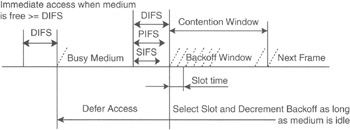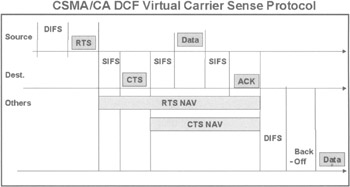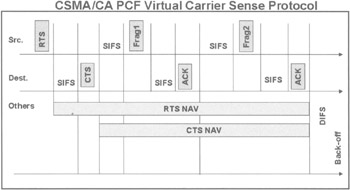QoS in 802.11
|
|
The consensus in the industry is that 802.11 alone does not offer adequate QoS. The IEEE has forwarded a new protocol designed to improve QoS in the original 802.11 MAC to enhance support for QoS-sensitive applications such as VoIP, videoconferencing, and streaming video. The original 802.11 MAC included two modes of operation: the distributed coordination function (DCF) and the point coordination function (PCF). The 802.11e draft specification introduces two new modes of operation: enhanced DCF (EDCF) and the hybrid coordination function (HCF). As with the original 802.11 MAC, the 802.11e enhancements are designed to work with all possible 802.11 physical layers (the original 802.11, the current 802.11, 802.11a, and 802.11g). The following sections describe QoS efforts in 802.11 and the mechanisms in 802.11e that are designed to improve QoS in wireless networks.[26]
Legacy 802.11 MAC
In order to dissect the progression to 802.11e as a QoS mechanism, it is first necessary to examine the legacy 802.11 MAC. The legacy 802.11 MAC includes support for two access mechanisms: DCF and PCF. In practice, almost all, if not all, commercial implementations use DCF exclusively. Refer to Chapter 2, "How Does 802.11 Work?" for review of the access mechanisms. Figure 5-6 illustrates the basic access method in DCF and PCF.

Figure 5-6: Basic access method in DCF and PCF
Distributed Coordination Function (DCF)
DCF is the basic 802.11 MAC. DCF is based on carrier sense multiple access with collision avoidance (CSMA/CA). CSMA/CA is very similar to Ethernet's carrier sense multiple access with collision detection (CSMA/CD); however, due to the implementation of the wireless transceiver, collision detection is not possible.
CSMA/CA
The primary QoS mechanism in 802.11 networks is collision avoidance using CSMA/CA. This is the method of sensing the medium and waiting before transmission. In CSMA/CA, stations listen to the medium to determine when it is free. Once a station detects that the medium is free, it begins to decrement its back-off counter (a sort of preemptive back-off). Each station maintains a CW that is used to determine the number of slot times a station has to wait before transmission. The back-off counter only begins to decrement after the medium has been free for a DIFS. If the back-off counter expires and the medium is still free, the station begins to transmit. It is possible that two nodes will begin to transmit at the same time. This causes a collision. Collisions (or other transmission problems) are detected by the lack of an acknowledgement from the receiver. After the detection of a collision, the station randomly picks a new back-off period from its CW (the CW grows in a binary exponential fashion similar to Ethernet) and then attempts to gain control of the medium again. Due to collisions and the binary back-off mechanism, there are no transmit guarantees with DCF. A pictorial representation of the DCF access mechanism is included in Figure 5-6.
Collision Avoidance Mechanisms
In order to avoid collisions, the DCF uses mechanisms for sensing whether the medium is in use before transmitting. If the medium is in use, the station will wait according to a predetermined algorithm before attempting to transmit. The DCF supports complementary physical and virtual carrier sense mechanisms.
Because each medium has different characteristics, physical sensing of the medium is called clear channel assessment (CCA). For example, a direct sequence radio PHY can be directed to report the medium to be in use in any of three separate conditions. The first condition reports an in-use condition if any energy above a defined threshold is detected on the medium. The second condition reports an in-use condition if any DSSS signal is detected. The last condition reports an in-use condition if a DSSS signal above a defined threshold is detected on the medium. Physical sensing is very efficient, but it is susceptible to the hidden-node problem (it cannot sense something that is out of range).
In virtual carrier sensing, no actual physical sensing of the medium occurs. Information about the use of the medium is exchanged through the use of control frames. As opposed to physical carrier sensing, virtual sensing greatly reduces the probability of collisions between hidden nodes on a network. It also reduces the overall throughput. This is due to the additional control frames that must be exchanged. Because this overhead is fixed, the smaller the data frames being sent, the higher the percentage of overhead that is added. In networks with a large amount of small packets or low collision rates, it is best to only use physical sensing. For this reason, the DCF's virtual carrier sensing mechanism is optional. The virtual carrier sense control messages are called Request to Send (RTS) and Clear to Send (CTS) frames. A frame size threshold (RTS threshold) can be set that allows a virtual carrier sense procedure only for packets greater than a specified size. The RTS/CTS procedure is not used for broadcast or multicast frames (single frames with multiple destinations) because this could generate multiple conflicting CTS responses. The virtual carrier sense mechanism also helps to avoid collisions when two overlapping basic service sets (BSSs) utilize the same radio channel for transmission.
In Figure 5-7, when node A wants to send data, it sends an RTS frame to the AP with addressing and timing information. It sends the address of the node that will receive the impending data frame (receiver address [RA]), its own address (transmitter address [TA]), and how long it wants to transmit (duration). The calculation of the duration has several elements. An AP receiving an RTS frame replies with a CTS frame. The CTS can be heard by all nodes within the AP's range. In forming the CTS frame, the AP copies the TA from the RTS into the RA of the CTS frame. It also copies the duration field into the CTS after adjusting it for the actual transmission of the CTS. The receipt of a CTS causes the receiver to store the duration field as its network allocation vector (NAV). The NAV is a timer that indicates the amount of time that remains before the medium can be used. This value counts down on a regular basis, and when it reaches zero, it indicates that the medium is free. It is updated every time an RTS or CTS with a larger value is received. By combining the physical sensing of the medium with the RTS/CTS procedure, it is possible for a hidden node that is unable to receive from the originating node to avoid collisions with an impending data transmission.

Figure 5-7: The relationship of CTS and RTS in CSMA/CA
In addition to the RTS and CTS control frames, the DCF CSMA/CA procedure requires an acknowledgement (ACK) frame to be sent upon successful receipt of certain types of frames. There is no negative acknowledgement (NACK), only a timer that indicates how long to wait for an ACK before the transmission is assumed to be in error. The DCF also provides several frame interval timers based on PHY-specific values. These interval timers represent the time that a station must take to sense that the medium is idle before starting a transmission. Two PHY-specific intervals serve as the basis for the other frame interval timers: the slot time and short interframe space (SIFS). The slot time for a DSSS PHY (20 ms) is defined as the sum of the receive-transmit turnaround time and the energy-detect time including any propagation delay. The slot time for the IEEE 802.11 frequency-hopping PHY is 50 ms. The SIFS is the shortest of the frame interval spaces and is used to allow the completion of an in-progress transmission. The SIFS for the DSSS PHY is 10 ms. The SIFS for the FHSS PHY is 28 ms.
The slot time and the SIFS are used as components in three other frame intervals. These are the DIFS, the extended interframe space (EIFS), and the PCF interframe space (PIFS). The DIFS is used by the DCF to enable the transmission of data and management MAC protocol data units (MPDUs). The EIFS is used to enable the processing of frames reported to be erroneous by the PHY layer. The PIFS gives a station priority access to the medium when operating in the PCF contention-free mode.
One other timer is used in the DCF virtual CSMA/CA capability: the back-off interval. If a station wanting to transmit detects that a transmission is in progress, it will wait before retrying the transmission. The back-off algorithm determines the time it waits, which is an exponential progression between minimum and maximum values. The starting value for this progression is calculated by multiplying a random number between the minimum and maximum back-off values with the slot time of the PHY. The back-off time is subsequently calculated as sequentially ascending integer powers of 2, minus 1. For example, if the random value is 3 and the slot time is 10 ms, the station would wait 7 or (23-1)×10 ms (70 ms). The retries would then continue using 15 (24-1) and then 31 (25-1) up to the maximum value between retries. Because a random number is used, two stations entering a transmission entry sequence usually do not arrive at the same back-off interval. This prevents two stations from repeatedly colliding because their retry sequences become synchronized. The station also has a retry counter that can limit the number of retries. Figure 5-8 illustrates the virtual carrier sense protocol.

Figure 5-8: Virtual carrier sense protocol
The DCF carrier sense protocol is a robust method of overcoming the challenges of radio data transmission between network peers. Centralized traffic management such as that provided by an AP is discussed next.
Data Fragmentation
The longer a transmission lasts, the greater the probability that it will be corrupted by interference. To allow the transmission of shorter frames and reduce the likelihood of interference, the IEEE 802.11 MAC provides a method of breaking transmissions into smaller units. This is called fragmentation. A value called the fragmentation threshold specifies that frames over a specified size should be divided into multiple transmissions. The frame header contains a sequence control field that shows the order of the fragments. Fragments constituting a frame are transmitted immediately after one another without any contention for the medium. Each fragment has its own cyclic redundancy code (CRC), and an individual ACK is transmitted for each fragment. The fragment transmissions are separated by the appropriate frame interval space. The transmission of a sequence of fragments is called a frame burst. If an error occurs on a fragment, subsequent fragments are not transmitted until the previous frame is acknowledged. The retransmission and back-off rules apply to fragmented frame transmissions. The NAV is set by duration information in the fragments and ACK. Broadcast and multicast frames are not fragmented even if their size exceeds the fragmentation threshold. Figure 5-9 illustrates frame fragmentation.

Figure 5-9: Frame fragmentation in virtual carrier sense protocol
Through the use of CSMA/CA and the definition of rules for peer-to-peer as well as centrally managed data transfers, the MAC layer provides reliable structured access to the PHY layer. Physical idiosynchrosies are masked from the upper layers enabling the Logical Link Control (LLC) functions and the whole suite of TCP/IP protocols.[27]
Point Coordination Function (PCF)
In an attempt to support limited QoS, 802.11 also defined the PCF. With PCF, the period after each beacon transmission is divided into two sections: the contention-free period (CFP) and the contention period (CP), which together constitute a superframe. The point coordinator (PC) (generally assumed to be co-located at the AP) provides guaranteed access to the medium in the beginning of the CFP by beginning transmission before the expiration of the DIFS. During the CFP, the PC lets stations have priority access to the medium by polling the stations in a round-robin fashion. The CFP is then followed by the CP, during which access to the medium is governed by DCF.
In PCF, the PC has no knowledge of the offered load at each station. The PC simply round-robin polls all stations that have indicated the desire to transmit during the CFP. Any station can request to be added to the poll sequence by a special frame exchange sequence during the CP.[28]
[26]Priyank Garg, Rushabh Doshi, Majid Malek, Russell Greene, and Maggie Cheng, Stanford University, "Achieving Higher Throughput and QoS in 802.11 Wireless LANs," a white paper from Stanford University, http://milliways.stanford.edu/~radoshi/cs444n/.
[27]James and Ruth LaRocca, 802.11 Demystified, (New York: McGraw-Hill, 2002), 141–142.
[28]James and Ruth LaRocca, 802.11 Demystified, (New York: McGraw-Hill, 2002), 141–142.
|
|
EAN: 2147483647
Pages: 96